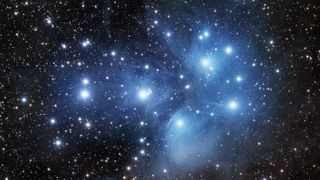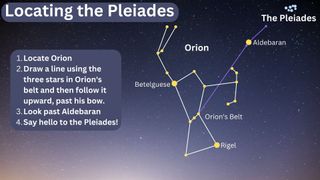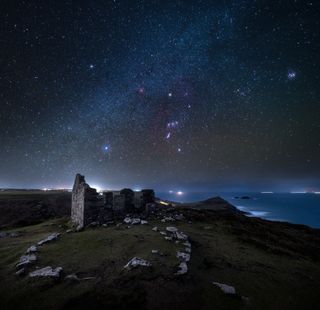The Pleiades: Facts about the "Seven Sisters" star cluster
The Pleiades is a bright star cluster and a popular skywatching target.

The Pleiades are an asterism, or pattern of stars, as well as an open star cluster, made up of more than 1,000 stars.
They are located in the constellation Taurus and are about 410 light-years from Earth.
Also known as the "Seven Sisters" and Messier 45, they derive their English name from Greek legend in which the stars represent the daughters of the ocean nymph Pleione.
As an open cluster, the stars in the Pleiades were all born around the same time from a gigantic cloud of gas and dust. The brightest stars in the formation glow a hot blue and formed within the last 100 million years. They are extremely luminous and will burn out quickly, with life spans of only a few hundred million years, much shorter than the billions of years our sun will enjoy.
Scientists estimate that the entire cluster is no more than 150 million years old, and possibly as young as 75 million, according to skywatching site Constellation Guide
Related: Night Sky — What you can see tonight [maps]
Where is the Pleiades located?

To find the Pleiades, you can start by locating the famous constellation Orion, the hunter. Draw a line using the three stars in Orion's belt and then follow it upward, past his bow.
The first bright star you'll see is Aldebaran, the eye of the bull Taurus, according to EarthSky. In Arabic, Aldebaran means "follower" since it follows the Pleiades across the sky. The cluster itself will be located just a bit past the bright star, visible as a small dipper-shaped arrangement of stars.
How can you see the Pleiades?
The Pleiades is visible pretty much everywhere around the world, with the exception of the Antarctic Circle, according to skywatching site Star Walk. In both hemispheres, the asterism is visible from October to April, according to the Online Star Register, and is visible all night in November.
As one of the nearest star clusters to Earth and the most obvious star cluster in the night sky, the Pleiades does not require any special equipment to view. However, while most people see six stars upon first glancing up at the Pleiades, observing the cluster in dark skies and allowing your eyes to adjust to the dark could allow you to observe up to 14 Using a pair of binoculars or a small telescope will allow you to see even more stars. If you are looking for equipment to help you observe the Pleiades, our lists of the best binoculars and best telescopes may help.

The Pleiades calendar
Many different cultures have used the appearance and position of Pleiades as a calendar. In ancient Greece and the Mediterranean, the first appearance of the Pleiades before sunrise denoted the start of the navigation season, according to EarthSky. In fact, the name Pleiades probably comes from the ancient Greek word "to sail."
Even the modern holiday of Halloween may be related to Pleiades. Many think that Halloween is descended, in part, from the old pagan festival of Samhain, celebrated by the ancient Celts and Druids of the British Isles. These ancient people may have observed the midnight culmination of Pleiades, or when Pleiades reached its highest point in the sky, at midnight on the day of this festival, which would have been celebrated around the time of Halloween. They believed that this signified the time of the thinnest separation between the world of the living and the world of the dead.
Mythology
The Pleiades are the seven daughters of the Titan god Atlas and the ocean nymph Pleione. During an ancient war, Atlas rebelled against Zeus, the king of the gods, who sentenced his foe to forever hold up the heavens on his shoulders. The sisters were so sad that Zeus allowed them a place in the sky in order to be close to their father. In other versions of the story, Zeus placed the sisters in the sky to protect them from Orion the hunter, who is represented in a nearby constellation.
In many different cultures, the Pleiades are associated with young girls being pursued by a young man or men, represented by Orion. Despite this, there is no proof that these cultures, such as the ancient Greeks and Aboriginal Australians, ever encountered each other. Many stories also explain why only six stars are usually visible, even in dark skies, to people with average eyesight. In Greek mythology, one sister left the stars after she fell in love with a mortal. In many Aboriginal Australian cultures, the seventh girl is hiding from the man or men represented by Orion, or has been abducted or killed.
By analyzing the motions of the Pleiades over time using data from the Gaia space telescope, writes astronomer Ray Norris, researchers can tell that the stars Atlas and Pleione used to be notably farther apart tens of thousands of years ago, which could have led ancient people to more commonly identify seven stars. The astronomer Robert Burnham Jr. suggested that this may also have occurred because Pleione is a shell star, varying substantially in brightness. Therefore, it would have sometimes appeared to be a part of Atlas, while sometimes appearing as a separate star.
The Pleiades FAQs answered by an expert
We asked Chris Mihos a few frequently asked questions about the Pleiades star cluster.

Warner Professor of Astronomy at Case Western Reserve University.
Where is the Pleiades in the night sky?
In the northern hemisphere, the Pleiades are visible high in the sky in late fall or winter evenings (Nov-Mar). (If you are an early riser, you can also see them in the pre-dawn hours in late summer or early fall.) Their position in the night sky changes from hour to hour and night to night due to the Earth's rotation and its orbit around the sun, so they aren't always in the same spot in the sky.
The easiest way to find them is to look to the south and find the constellation Orion. Then find the three stars that make up Orion's belt, and use them as pointers: follow them up and to the right, where you will find the bright red star Aldebaran and then, just a bit further on from there, the Pleiades.
In the southern hemisphere, things are flipped. The time of year doesn't change — it's still the Nov-Mar range — but of course, this is the southern hemisphere's late spring or summer, and the Pleiades will be much lower in the sky from the southern hemisphere. To find them, look to the north to find Orion, then follow his belt stars in a line, this time down and to the left, passing Aldebaran before coming to the Pleiades.
How many stars make up the Pleiades?
Depending on how keen your eyes are and how dark your sky is, you can spot maybe 7 or so stars in the cluster, but these are really just the very brightest stars in the Pleiades. If you look at the cluster with binoculars, you'll see many many more stars in the cluster as well. Most of the stars in the Pleiades are much fainter (even than can be seen with binoculars), and astronomers estimate there may be as many as 1,000 or so stars in the cluster, all told.
How has the Pleiades changed over time?
From night to night, on human timescales, we don't see the Pleiades changing with time. But they are changing! The cluster was born only about 100 million years ago (quite recently in terms of the age of our Milky Way Galaxy). As the cluster ages, over hundreds of millions of years, it will slowly lose its stars — some reaching the end of their lives and dying, others drifting away from the cluster and being lost from it entirely as the cluster slowly dissolves to become part of the general population of stars in the Milky Way's disk.
Additional resources
Read more about the Pleiades from astronomer Steven Gibson. Learn more about the Greek mythology of the Pleiades with these resources from Greek mythology site Theoi Project. Explore how ancient Greeks and Aboriginal Australians saw constellations in common with this article by Duane W. Hamacher published on The Conversation.
Bibliography
Constellation Guide, Pleiades: The Seven Sisters (Messier 45): https://www.constellation-guide.com/pleiades-the-seven-sisters-messier-45/
EarthSky, Pleiades — or 7 Sisters — known around the world: https://earthsky.org/favorite-star-patterns/pleiades-star-cluster-enjoys-worldwide-renown/
StarWalk, The Pleiades: One of the Best Naked-Eye Deep-Sky Objects:
https://starwalk.space/en/news/m45-pleiades-star-cluster
Online Star Register, The Pleiades Star Cluster:
https://osr.org/blog/kids/the-pleiades-star-cluster/
EarthSky, Halloween is a cross-quarter day:
https://earthsky.org/astronomy-essentials/halloween-derived-from-ancient-celtic-cross-quarter-day/
The Conversation, The world's oldest story? Astronomers say global myths about 'seven sisters' stars may reach back 100,000 years:
Join our Space Forums to keep talking space on the latest missions, night sky and more! And if you have a news tip, correction or comment, let us know at: community@space.com.
Get the Space.com Newsletter
Breaking space news, the latest updates on rocket launches, skywatching events and more!

Rebecca Sohn is a freelance science writer. She writes about a variety of science, health and environmental topics, and is particularly interested in how science impacts people's lives. She has been an intern at CalMatters and STAT, as well as a science fellow at Mashable. Rebecca, a native of the Boston area, studied English literature and minored in music at Skidmore College in Upstate New York and later studied science journalism at New York University.
